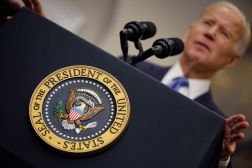How big data helped fix Healthcare.gov’s UX problem
The troubled rollout of Healthcare.gov in 2013 may have been an initial hassle for Americans seeking affordable health insurance, but one member of the U.S. Digital Service said it taught the government some good lessons on managing user experience with big data.
Mina Hsiang, the health data lead within USDS, spoke Thursday at MarkLogic’s Data Innovation Summit, produced by FedScoop, about specific techniques the digital squad, tasked with rescuing the flawed Affordable Care Act site, used to better serve its visitors.
“We were asked, ‘Can you get it fixed and make it work by Thanksgiving?'” Hsiang said of the site, which launched Oct. 1 that year. “It was a huge consumer-facing effort to engage people, and there were a few different, interesting opportunities to use data to improve that.”
An immediate technique her team, which laid the foundation for USDS, used was user funneling, which, as she explained, meant “tracking basically the number of people at every stage in an application or a Web page and what actions they are taking. It starts to look like a branching tree.”
This not only showed where users tended to get caught up or confused while navigating Healthcare.gov, “but it also told us where technology wasn’t working,” she said. “Using user funnels really helped elucidate technical challenges.”
One point Hsiang, who also serves as health data adviser to U.S. Chief Technology Officer Megan Smith, reiterated during her talk was the importance of making life easier for American citizens engaging with their government. And big data, she said, could help.
“Make life easier for your customers,” Hsiang said. “Instead of requiring the user to go out and find their IRS forms and find the Social Security verification … why would we make our users enter data that they’ve already entered in other systems when we’re the provider and we should know all that information about them?”
Many industry applications allow users to sign in using credentials from third parties, like Facebook or Twitter, instead of creating another account. Not only does that make the user’s experience more efficient, but the company also gets the data it needs.
“They already know certain things about me, and that allows them to serve me better,” she said. “I think there are opportunities for us in government to take that approach and make life easier for our constituents.”
Hsiang listed several other opportunities for the federal government to better serve citizens: It could use data for targeted campaigns or develop tools that guide Americans to the logical next step when submitting forms or applying for services, much like how Amazon recommends products similar to those its users already bought.
However, she did warn, “You have to toe the line of being creepy and convenient” when using this sort of predictive analytics. For example, if LinkedIn recommended you connect with someone you just met at, say, a FedScoop event, you feel as though someone’s watching over your shoulder, she said.
“In truth, they’ve been on your list all along,” Hsiang reassured the audience. “You just never met them [until now], so you didn’t notice.”
In private industry, she said, they call that “surprise vs. delight,” and they’ve learned transparency can help alleviate the concern.
“All of the things we’ve outlined are tremendous opportunities to make people’s lived easier, but we should be transparent as government,” Hsiang said. “People are concerned about the amount of data we have, so I think it’s tremendously even more important for us to be incredibly transparent about how we surprise and delight customers — but I don’t think that means we shouldn’t do it.”






